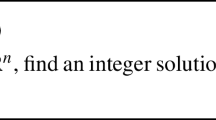Abstract
In this paper we investigate the use of a system of multivariate polynomials to represent the restrictions imposed by a collection of constraints. One advantage of using polynomials to represent constraints is that it allows many different forms of constraints to be treated in a uniform way. Systems of polynomials have been widely studied, and a number of general techniques have been developed, including algorithms that generate an equivalent system with certain desirable properties, called a Gröbner Basis. General algorithms to compute a Gröbner Basis have doubly exponential complexity, but we observe that for the systems we use to describe constraint problems over finite domains a Gröbner Basis can be computed more efficiently than this. We also describe a family of algorithms, related to the calculation of Gröbner Bases, that can be used on any system of polynomials to compute an equivalent system in polynomial time. We show that these modified algorithms can simulate the effect of the local-consistency algorithms used in constraint programming and hence solve certain broad classes of constraint problems in polynomial time. Finally we discuss the use of adaptive consistency techniques for systems of polynomials.
Similar content being viewed by others
References
Rossi, F., van Beek, P., Walsh, T.(eds.): The Handbook of Constraint Programming. Elsevier (2006)
Aiba, A., Sakai, K., Sato, Y., Hawley, D., Hasegawa, R.: Constraint logic programming language CAL. In: Proceedings of the International Conference on Fifth Generation Computer Systems, pp. 263–76. Ohmsha Publishers (1988)
Granvilliers, L., Monfroy, E., Benhamou, F.: Symbolic-interval cooperation in constraint programming. In: Proceedings of ISSAC 2001, pp. 150–166 (2001)
Hong, H.: RISC-CLP(Real): constraint logic programming over real numbers. In: Benhamou, F., Colmerauer, A. (eds.) Constraint Logic Programming: Selected Research. MIT Press, Cambridge (1993)
Monfroy, E.: The constraint solver collaboration language of BALI. In: In Proceedings of JCSLP 1998, pp. 349–350 (1998)
Clegg, M., Edmonds, J., Impagliazzo, R.: Using the Groebner basis algorithm to find proofs of unsatisfiability. In: Proceedings of the 28th ACM Symposium on Theory of Computing, STOC ’96, pp. 174–183. ACM Press (1996). doi:10.1145/237814.237860
Sakai, K., Sato, Y.: Boolean Gröbner bases. Tech. Rep. 488, ICOT (1988)
Sato, Y., Suzuki, A., Inoue, S., Nabeshima, K., Sakai, K.: Boolean Gröbner bases. J. Symb. Comput. 46, 622–632 (2011). doi:10.1002/10.1016/j.jsc.2010.10.011
Conti, P., Traverso, C.: Buchberger algorithm and integer programming. In: AAECC, pp. 130–139 (1991)
Urbaniak, R., Weismantel, R., Ziegler, G.M.: A variant of the Buchberger algorithm for integer programming. SIAM J. Discrete Math. 10(1), 96–108 (1997)
Buchberger, B.: Ein Algorithmus zum Auffinden der Basiselemente des Restklassenringes nach einem nulldimensionalen polynomideal (an algorithm for finding the basis elements in the residue class ring modulo a zero dimensional polynomial ideal). Ph.D. thesis, Mathematical Institute, University of Innsbruck, Austria (1965). (English translation in J. of Symbolic Computation, Special Issue on Logic, Mathematics, and Computer Science: Interactions, vol. 41, no. 3–4, pp. 475–511 (2006))
Buchberger, B.: Ein algorithmisches Kriterium fuer die Loesbarkeit eines algebraischen Gleichungssystems (an algorithmic criterion for the solvability of algebraic systems of equations). Aequationes Math. 3, 374–383 (1970) (English translation: Buchberger, B., Winkler, F.: Groebner Bases and Applications. In: Proc. of the International Conference “33 Years of Groebner Bases”, 1998, RISC, Austria, London Math. Society Lecture Note Series 251, pp. 535–545. Cambridge Univ. Press (1998))
Buchberger, B.: Gröbner bases: An algorithmic method in polynomial ideal theory. In: Bose, R. (ed.) Multidimensional Systems Theory, Mathematics and Its Applications, chap. 6, pp. 184–232. D. Reidel Publishing Company (1985)
Cox, D., Little, J., O’Shea, J.: Ideals, Varieties, and Algorithms An Introduction to Computational Algebraic Geometry and Commutative Algebra. Springer (1996)
Becker, T., Weispfenning, V.: Gröbner bases a computational approach to commutative algebra. In: Graduate Texts in Mathematics. Springer (1993)
Nethercote, N., Stuckey, P.J., Becket, R., Brand, S., Duck, G.J., Tack, G.: MiniZinc: towards a standard CP modelling language. In: Principles and Practice of Constraint Programming, pp. 529–543. Springer (2007)
Buchberger, B., Moeller, M.: The construction of multivariate polynomials with preassigned zeros. In: Computer Algebra, EUROCAM 82. LNCS, vol. 144, pp. 24–31 (1982)
Gault, R., Jeavons, P.: Implementing a test for tractability. J. Constraints 9, 139–160 (2004)
Adams, W., Loustaunau, P.: An introduction to Gröbner bases. In: Graduate Studies in Mathematics. American Mathematical Society (1994)
Bayer, D., Mumford, D.: What can be computed in algebraic geometry? In: Eisenbud, D., Robbiano, L. (eds.) Computational Algebraic Geometry and Commutative Algebra, pp. 1–48. Cambridge University Press, Cambridge (1992)
Lazard, D.: Gröbner-bases, Gaussian elimination and resolution of systems of algebraic equations. In: Proceedings of the European Computer Algebra Conference on Computer Algebra, EUROCAL’83, pp. 146–156. Springer-Verlag, London (1983)
Cooper, M.: An optimal k-consistency algorithm. Artif. Intell. 41, 89–95 (1989)
Freuder, E.: A sufficient condition for backtrack-bounded search. J. ACM 32, 755–761 (1985)
Jeavons, P., Cooper, M.: Tractable constraints on ordered domains. Artif. Intell. 79(2), 327–339 (1995)
Dechter, R.: Constraint Processing. Morgan Kaufmann, San Mateo (2003)
Dechter, R.: Bucket elimination: a unifying framework for reasoning. Artif. Intell. 113(1–2), 41–85 (1999)
Jeavons, P., Petke, J.: Local consistency and SAT-solvers. J. Artif. Intell. Res. (JAIR) 43, 329–351 (2012)
Faugére, J.C.: A new efficient algorithm for computing Gröbner Bases (F4). J. Pure Appl. Algebra 139, 61–88 (1999)
Faugére, J.C.: FGb: a library for computing Gröbner Bases. In: Fukuda, K., Hoeven, J., Joswig, M., Takayama, N. (eds.) Mathematical Software - ICMS 2010. Lecture Notes in Computer Science, vol. 6327, pp. 84–87. Springer, Berlin Heidelberg (2010)
Author information
Authors and Affiliations
Corresponding author
Additional information
Christopher Jefferson was supported by EPSRC Grant EP/D032636/1 and Martin Green was supported by EPSRC Grant EP/C525949/1.
Rights and permissions
About this article
Cite this article
Jefferson, C., Jeavons, P., Green, M.J. et al. Representing and solving finite-domain constraint problems using systems of polynomials. Ann Math Artif Intell 67, 359–382 (2013). https://doi.org/10.1007/s10472-013-9365-7
Published:
Issue Date:
DOI: https://doi.org/10.1007/s10472-013-9365-7




